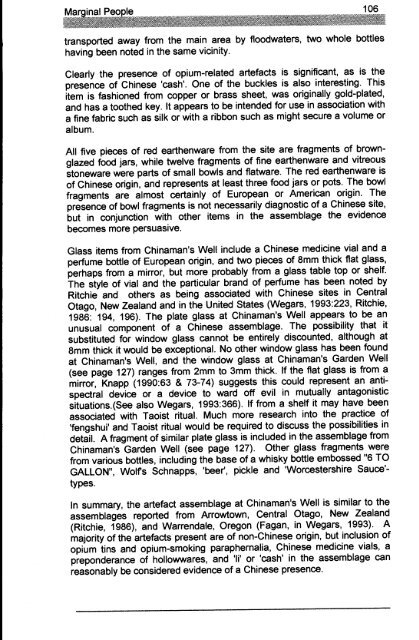Adec Preview Generated PDF File - The Sydney eScholarship ...
Adec Preview Generated PDF File - The Sydney eScholarship ...
Adec Preview Generated PDF File - The Sydney eScholarship ...
You also want an ePaper? Increase the reach of your titles
YUMPU automatically turns print PDFs into web optimized ePapers that Google loves.
transported away from the main area by f1oodwaters, two whole bottles<br />
having been noted in the same vicinity.<br />
Clearly the presence of opium-related artefacts is significant, as is the<br />
presence of Chinese 'cash'. One of the buckles is also interesting. This<br />
item is fashioned from copper or brass sheet, was originally gold-plated,<br />
and has a toothed key. It appears to be intended for use in association with<br />
a fine fabric such as silk or with a ribbon such as might secure a volume or<br />
album.<br />
All five pieces of red earthenware from the site are fragments of brownglazed<br />
food jars, while twelve fragments of fine earthenware and vitreous<br />
stoneware were parts of small bowls and flatware. <strong>The</strong> red earthenware is<br />
of Chinese origin, and represents at least three food jars or pots. <strong>The</strong> bowl<br />
fragments are almost certainly of European or American origin. <strong>The</strong><br />
presence of bowl fragments is not necessarily diagnostic of a Chinese site,<br />
but in conjunction with other items in the assemblage the evidence<br />
becomes more persuasive.<br />
Glass items from Chinaman's Well include a Chinese medicine vial and a<br />
perfume bottle of European origin, and two pieces of 8mm thick flat glass,<br />
perhaps from a mirror, but more probably from a glass table top or shelf.<br />
<strong>The</strong> style of vial and the particular brand of perfume has been noted by<br />
Ritchie and others as being associated with Chinese sites in Central<br />
Otago, New Zealand and in the United States (Wegars, 1993:223, Ritchie,<br />
1986: 194, 196). <strong>The</strong> plate glass at Chinaman's Well appears to be an<br />
unusual component of a Chinese assemblage. <strong>The</strong> possibility that it<br />
substituted for window glass cannot be entirely discounted, although at<br />
8mm thick it would be exceptional. No other window glass has been found<br />
at Chinaman's Well, and the window glass at Chinaman's Garden Well<br />
(see page 127) ranges from 2mm to 3mm thick. If the flat glass is from a<br />
mirror, Knapp (1990:63 & 73-74) suggests this could represent an antispectral<br />
device or a device to ward off evil in mutually antagonistic<br />
situations.(See also Wegars, 1993:366). If from a shelf it may have been<br />
associated with Taoist ritual. Much more research into the practice of<br />
'fengshui' and Taoist ritual would be required to discuss the possibilities in<br />
detail. A fragment of similar plate glass is included in the assemblage from<br />
Chinaman's Garden Well (see page 127). Other glass fragments were<br />
from various bottles, inclUding the base of a whisky bottle embossed "6 TO<br />
GALLON", Wolfs Schnapps, 'beer', pickle and 'Worcestershire Sauce'types.<br />
In summary, the artefact assemblage at Chinaman's Well is similar to the<br />
assemblages reported from Arrowtown, Central Otago, New Zealand<br />
(Ritchie, 1986), and Warrendale, Oregon (Fagan, in Wegars, 1993). A<br />
majority of the artefacts present are of non-Chinese origin, but inclusion of<br />
opium tins and opium-smoking paraphernalia, Chinese medicine vials, a<br />
preponderance of hollowwares, and 'Ii' or 'cash' in the assemblage can<br />
reasonably be considered evidence of a Chinese presence.




